Some of the best lines I have found in English about French hunting, were in "A Sporting
Chance" by Daniel P. Mannix - published by E.P. Dutton & Co, New-York 1967. Here they are...
"Although the French stag hunt is admittedly a pageant as much as a hunt, its a good deal more than simply
an excuse for people to wear picturesque costumes and go through a lot of forms and ceremonies. The members of the
hunt ride hard and well. Broken bones are not uncommon, and to kill a big stag with a dagger requires a considerable
amount of courage and dexterity. The most important feature of the hunt is the work of the hounds. The organization
and direction of the pack are considerably more complicated than in any other form of hunting and most hunters
are far more interested in watching the hounds in action than in making a successful kill. As the count told me:
"In England, people hunt in order to ride. In France, we ride in order to hunt"...
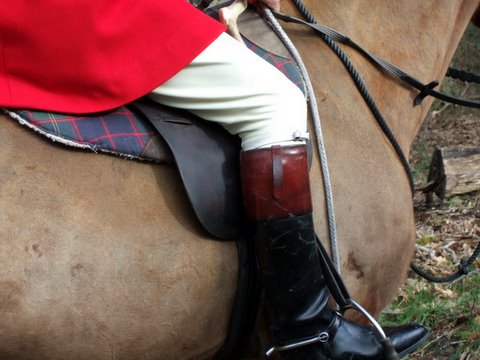
Detail of attire: British huntsman visiting us.
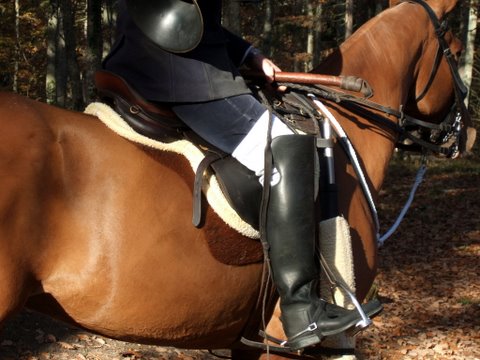
French huntsman.
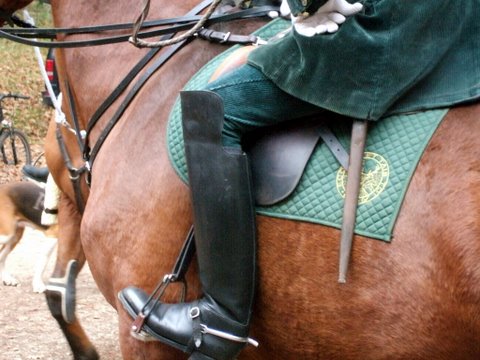
French hunter in green livery

French hunter in blue livery
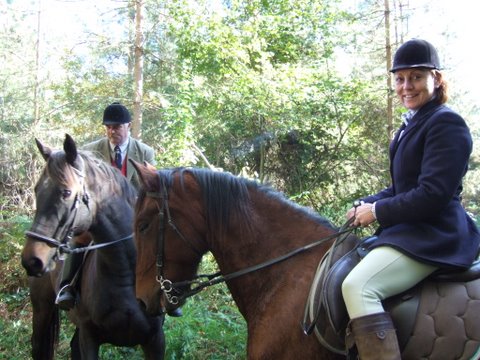
British guests in gentleman's attire
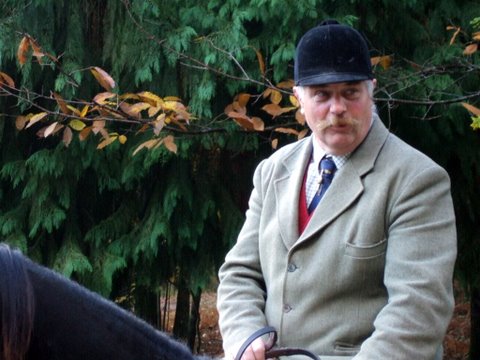
but superbly looking !!!!
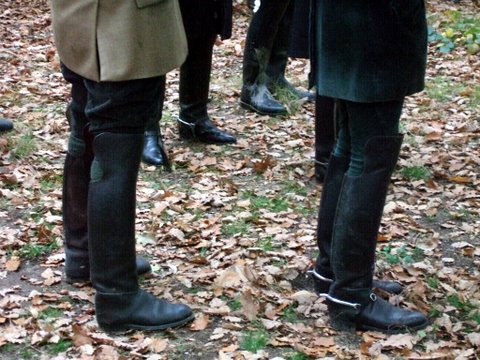
French boots
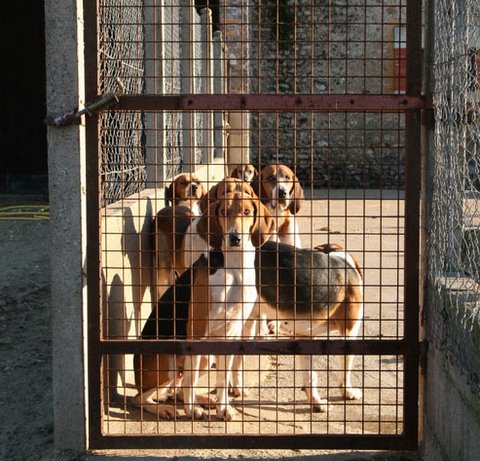
Visiting kennels is always a highlight for true hunters
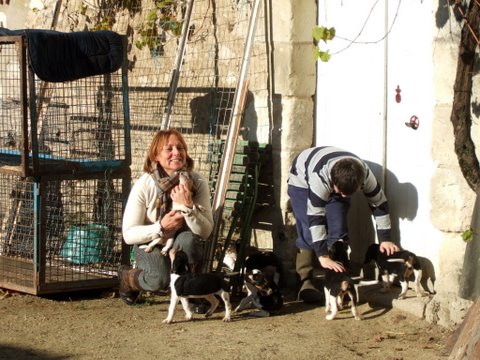
Some would like to fly back with a puppy. Sometimes we can arrange it....
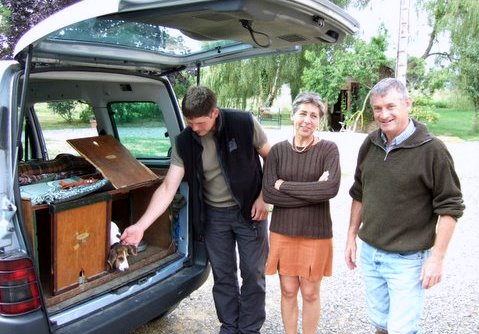
This (very) young bitch of a boar pack, flew to Norway to become a moose dog !
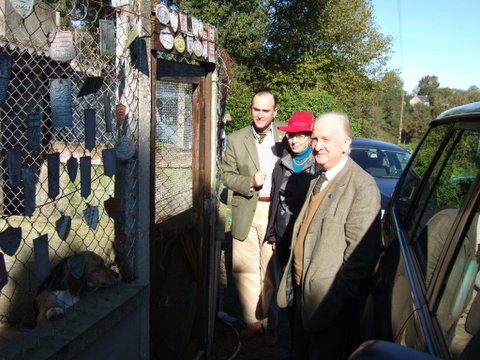
Buck & Josie visiting the kennel of Dr Jacques Bourdon, president of the French Beagle Club
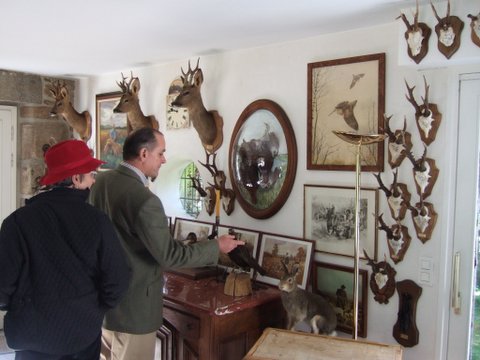
And admiring his collections. My friend Buck is the master of "Clear Creek Beagles" in Kentucky.
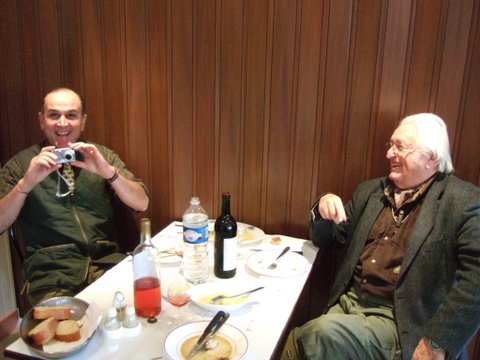
Here enjoying a Brittany bistrot with the legendary president Noël Lefeuvre, of the CNB (our French Woodcock Society).
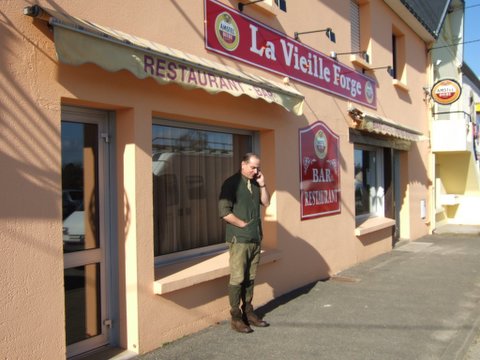
The most remote French restaurant is never far from the NYSE
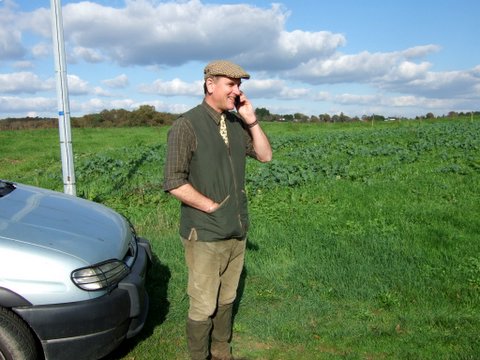
and even afield cell phones are working !
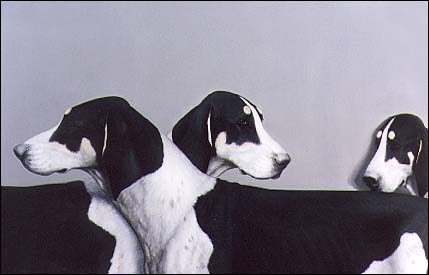
Grand chien français noir et blanc, by François Lebert
Websites to visit...
Venerie.org
Official webpage of French hunters
Don't miss !
Le Hourvari
The wonderful online catalogue of all the attire, tack & little
curiosities of the French hunting world. If you wanted to order
something
and needing advice or help for communication, do not hesitate to
contact us.
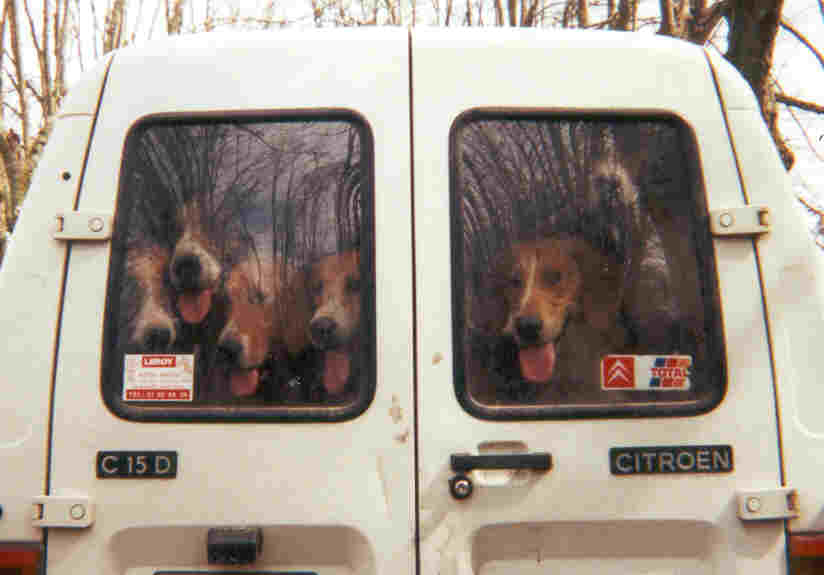
Continued on..
Riding to hounds in France, page # 1, 2 & 4
Read below...
SHAKERAG GOES TO FRANCE - By Walter B. Cheatham, March 2004
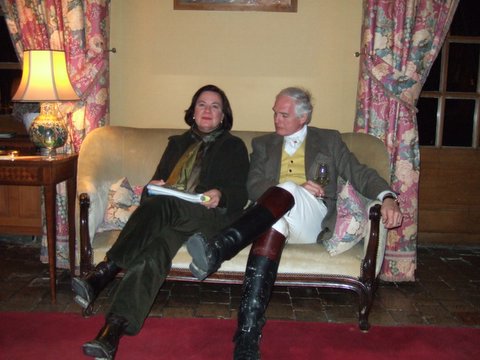
A well deserved glass and rest after long hunting and writing...
SHAKERAG GOES TO FRANCE -
For years I've wanted to go stag hunting in
France
ever since I read an article in a now-defunct horse magazine and saw the women
in tricorn hats and the men with French horns over their shoulders. The French
have a way of making our scarlet coats seem a trifle drab.
Then, too, there's the history. As most of you know, our own hunting traditions
have roots in France.
The French hunting traditions followed the Normans
into England and years later
evolved onto the hunting traditions brought to America by colonial settlers such
as George Washington's friend, Lord Fairfax. The Marquis de Lafayette even sent
a gift of hounds to Washington after he
returned to France.
So, after a false start last year, I started to do some research on hunting there.
Howard Benson and Dorothy Kirkley were both high on the idea and wanted to go,
too. I found several web sites that helped. (For those of you with some
interest you can go to the French equivalent of the MFHA, the Societe de Venerie,
at http://www.venerie.org/. With the
exception of the website of one hunt in Normandy
that has joint meets with a hunt across the channel, it's all in French.
However the pictures are great and so is the sound.)
After some reading, we decided to hunt in the Loire Valley.
There is a chateau there, that operates as a hotel and will arrange hunting. In
fact, the owner is a master of a hare pack and is a regular hunter and shooter.
He and his wife, the comte and comtesse Béraud de Vogué, are charming hosts.
They have lived in Canada
and California
and speak fluent English. And the chateau is spectacular with very up-to-date
facilities. But don't let the title fool you. Béraud may be a count, but he'll
make you feel like a long lost friend.
The three fearless Shakerag members rolled into the chateau on a Friday night,
along with Sheila (who was wearing her antique dealer's hat) and Gloria (who
claimed she was just part of the luggage, but who I know was the biggest
Francophile among us). We were in two cars, since we wanted the non hunting
members of the party to have their own transportation (not to mention the fact
that we had packed just about every piece of clothing we owned). Shortly after
we arrived, we were invited to join our hosts Diane and Béraud de Vogué for a
drink. Actually, the maid came and said, "The Count will see you at ten
past seven." That made us all straighten up a bit, but Béraud turned out
to be in shooting clothes, corduroy knickers, suede vest, tweed jacket, the
quintessential country gentleman. The gun season had ended that day, and he had
hosted a shoot for those who served as beaters during the season. He raises
about two thousand pheasants a year for his shooting guests. Sort of the Loire Valley's
answer to Thomasville.
Over drinks, Béraud gave us our plans. Saturday we were to hunt with Frederic Poisson, the master of the Rallye de la Brie. (Hunts are either
"rallyes" or "équipages," and there seems to be no
difference, just a name, like in America you could call yourself
"hunt" or "hounds.") The Rallye de la Brie is a stag hunt that has
rights in the Foret d´Orleans, a national forest, where they have license to
kill forty stags a season. (They even are issued tags. The paper tags that come
on a Georgia
deer license are the idea, but these look like plastic wire ties.)
On Sunday we were to hunt at the chateau
with our host's hare hunt, the Equipage Bouquin Berrichon. (I had thought of
hare hunting as behind beagles or bassets on foot. But Béraud's hounds were the
size of foxhounds and needed all that speed.) On Tuesday we were to hunt with
G.M. , master of the Equipage Piqu'Avant Sologne, a private pack, south of the
chateau. And on Wednesday, we were to be back with Frederic
Poisson.
General observations from the first day include the fact that hunting people
are friendly, even to strangers who don't speak their language. The riding is
easy, but you don't enjoy it as much, until you figure out what's going on. And
the pageantry is a sight to see. The Rallye de la Brie
members wore navy frock coats with green velvet collars, cuffs and vests accented
with lots of gold braid, and over-the-knee boots. Most of the men carried the
French horns I'd seen in the photos, and they blew an entire medley of hunting
tunes as we started out.
We were placed on hired horses with worn, school-quality tack. Dorothy's horse
was fine, as was mine. But Howard had a trotter. (Later we learned that the
cheapest horseflesh in France
is a trotter off the track. Our host said you could pick them up for six
hundred euros. I did the math: one euro per kilo.) Howard will tell you that
getting a trotter is not a good thing, since you will be on horseback four to
six hours. It can be longer.
In the national forests, only the huntsman and a couple of assistants (sort of
like whips, but not quite) are allowed to leave the road. So the field rides
the roads and spreads out to watch at the crossings. There is no field master
and you go wherever you please. We followed a couple of different members, and
after an hour of so, the hounds started a stag. We got lucky and viewed him
breaking from the brush and running across a cutover field. The master's son
directed us to the next crossing and then down the road in the direction the
hounds were running. We got very worried we were going to head the game. (More about
that later.) After
some good hound music and another view, we zigged when we should have zagged
and found ourselves alone and out of earshot. Finding a member who knew what
she was doing, we followed her about six miles. She was on a gaited horse doing
what looked like a walking horse's running walk. Dorothy and I cantered, and
Howard gritted his teeth and trotted.
We finally caught up with the field,but the stag had headed to an area where
they were not allowed to hunt. Then either the hounds lost the quarry or the
master lifted them, and we headed back to the meeting point. The meet was at a
memorial where the Germans had shot about a dozen resistance fighters. There we
spread our picnics, and were treated to glasses of champagne. Everyone came
over and greeted us, most in French, but many in English, even if
"hello" was all the English they could muster. We shared the wine and
smoked salmon sandwiches the chateau had packed for us and had informative
conversations with the English-speaking members.
On Sunday, we had an excellent lunch with our host (of wild duck from the chateau's
lake), and Howard and I went to his kennels for his regular hare hunt. The
scenting was not good due to very dry air with intermittent snow. We flushed
only one hare, and lost him quickly on the edges of a rapeseed field, but we enjoyed the
afternoon nonetheless. Since it was Béraud's land, we could follow the hounds
through the woods rather than being confined to the roads, and we learned more
about the local traditions. I noticed one member in the typical long frock
coat, which had the hunt's buttons, but which was plain black (rather than the hunt's
colors with contrasting velvet cuffs like other memberswore). Béraud explained
that his hunt had three levels of membership. At the lowest level of
subscription you could wear a stock pen mounted with the hunt button. At the
next level you wore the coat buttons but not the colors. At a full membership,
you wore colors and all the buttons.
On both hunts, members carried either short reed horns or the traditional French
horn with regular mouthpiece. Some carried both. They would use the short horns
to signal or call hounds and the French horns to blow the special calls and
salutes. Each hunt has its own "fanfare," while other calls and
salutes are common to all. The horns really add to the experience. Howard
commented later that a master had to be a good hound man, a good horseman and a
musician.
On Tuesday, the three of us all hunted with G.M. his brother, Hubert, and his
wife, Bridget. That was the entire field. Gerard keeps a pack of 200 hounds,
leases the rights to a national forest, has bought much of the adjoining land,
and hunts with his brother three days a week. In addition, he owns land in Argentina and
was going there with his pack to hunt for a month in April. Cotton does not get
any higher.
Gerard hauled fifty-seven hounds to the meet. Present at the meet were some
hunt supporters, who were to be car followers, and some paid staff. Gerard
culled out three hounds, and then we mounted and followed. We were told we
could follow Gerard, but to give him lots of space. Thus when he stopped, we
faced our horses to the woods where the hounds were casting, at some distance
from the master. To our surprise he called us up, saying we should always stop
at a crossroad so you can watch two ways.
Within minutes, the hounds started three stag, and we kept with Gerard. I was
surprised that only part of the pack made chase, while a good portion of the
pack stayed with the master. As it turned out, they joined the chase only after
the one stag to be hunted was singled out. As we
followed, Gerard took off cross-country, and we held back to stay on the roads,
as we had been taught to do with the Rally de la Brie in order to comply with
the rules of the national forest. However, Bridget said to follow her husband,
which we gladly did. (I assume with a field of only three, the road strictures
in the national forest can be stretched.)
Following Gerard cross-country was great fun. We saw the good hound work and
saw the stag at close quarters several times. Once we passed four stag standing
off a trail some fifty yards away. They seemed to know they were not being
hunted and just stood there. After a chase of just under two hours at full gallop,
or in Howard's case, a heckuva trot (ouch), the stag went to bay in a small
pond. A few hounds swam after him, and everyone with a French horn blew the
proper calls. Hubert hopped off his horse, shed his coat and rolled up his
sleeves. They then took a plastic rowboat off the hound truck and pulled it
through the woods to the pond. My horse had hunted before, but a plastic bateau
bouncing through the woods was a new experience for him. I don't know how the
others reacted, since I was very occupied with my own mount at the time. Hubert
got in the boat and a few strong pulls allowed him to catch the stag. He
dispatched him with his
dagger and rowed him ashore.
There followed quite a bit of horning, and we loaded the stag in the hound truck
and hacked back. We learned we finished very early. Apparently, two hours is
not much of a chase. Normal
is more like three-and-a-half, and chases of five or six hours are not unusual.
We found our way back to the kennels and went into the trophy room (I can not
count high enough to say haw many trophies there were), and we laid our picnic
on a long table. After a while, Bridget came in and got involved with some
activity in the kitchen. Then Gerard came in and invited us to come outside. He
and Hubert took us behind the kennels. They had dressed again in their formal
attire and the stag was on the ground. The brothers took turns blowing salutes,
as did some car followers with horns, after which the hounds were led within a
foot of the stag. No hound broke ranks. Then the pack was taken about forty
yards away and lined up in quivering anticipation. At the signal from Gerard,
the pack thundered toward the stag. As they started, a man lifted the head and
with it the skin, as the stag had been prepared earlier. The pack was allowed
to devour the carcass. I understand that feeding the game to the hound in this
fashion is the norm. When the hounds finished, Gerard approached Dorothy, and
presented her with a foot of the stag. It was skinned above the hoof, and the
loose skin was twisted into a braid. This is the stag equivalent of being
awarded the brush.
After the honors, we were invited back into the trophy room for drinks and lunch.
Our picnic had been discreetly moved aside and the table set. We were treated
to a proper French lunch of soup, coq au vin, cheese and chocolate mousse. We
could get used to this. We headed back to the chateau feeling ten feet tall. We
told the stories of the day over and over to each other, to Gloria and Sheila
when they joined us, and then again to Béraud when he joined us later for
drinks. (Gloria would say "still more drinks," claiming that we were
potted with booze and excitement by the time she and Sheila arrived, but she
exaggerates.)
The next day Howard and I joined the Rallye de la Brie as planned and, having
learned a lot, were much more on top of what was going on. We knew where we
should be and what we should be looking for. We even got separated and easily
found the field again. We were there when they started the stag and there when
he went to bay. Once more this was in water. (We were told that going to bay in
water occurred about sixty percent of the time.) This time it was in a large
lake, and the stag swam more, hid in the reeds and did more to evade the
master. Ultimately, however, he was cornered and dispatched. The whole time he
was in the lake the members were horning, and at the death, all the men removed
their hats as the proper call was blown.
We gathered at a nearby crossroads, and Howard and I caught a lift back to our
car. It was about seven miles away, but I can easily believe we covered
twenty-five in our "short" chase of just over two hours. Picnics were
spread on car hoods, and once more we truly enjoyed the
company. The hounds were fed in the same ceremony. This time, as part of the
honors, they played God Save The Queen for some English visitors on French
horns, of course.
All in all, our experience hunting in France could not have been better. The
people could not have been nicer. Béraud, our host, could not have done more.
He made the arrangements as hassle free as could be. Catch anyone of us and we
will tell you more than you want to hear, at the slightest excuse.
Random observations (about hunting and otherwise):
-Turn out was not at a very high state for the average hunter. Great looking
coats but not well kept, although there were some notable exceptions. Many
hunters looked like they were wearing great-great-great granddad's coat and
didn't own a brush.
-Immediately following the hunt, the members change into regular winter coats,
but they put back on their frock coats for the ceremony.
-As here, each hunt has its own button, but unlike here, they all wear stock
pins with the hunt's button mounted on it. Also unlike here, the stock pin is
worn vertically. You'll see what I mean next season, since Gloria and Sheila
hunted down the store in Paris
where you get the pins and are having some made for us with Shakerag's button.
-The best looking horses were clipped. It looked like a normal hunter clip,
except the faces were not clipped. They stopped at the line of the bridle
cheeks, and manes were roached.
-The best meal we had in France was in the little village of Vailly,
about seven miles from the chateau. Le Lièvre Gourmand (Gourmet Hare) has just gotten
its first Michelin star. The owner's parents are Australian so his English was
excellent. The food was remarkable, and the six table dining room elegant.
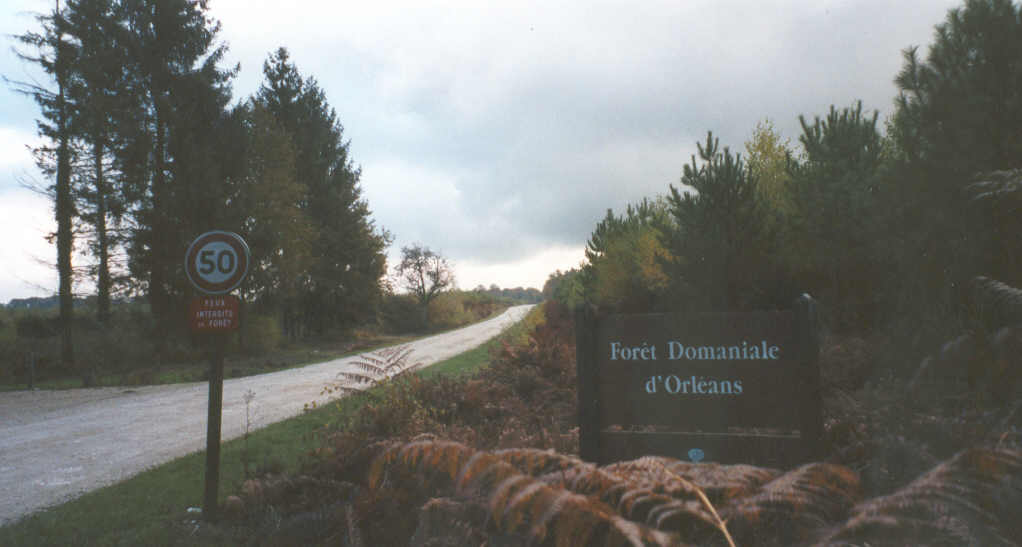
Continued on..
Riding to hounds in France, page # 1, 2 & 4


